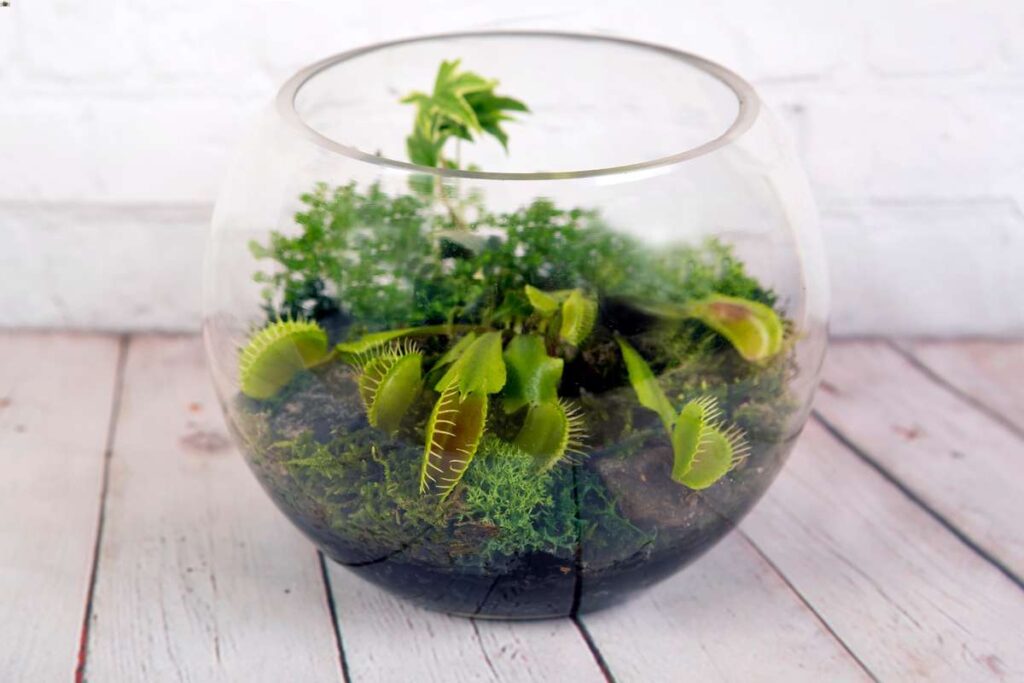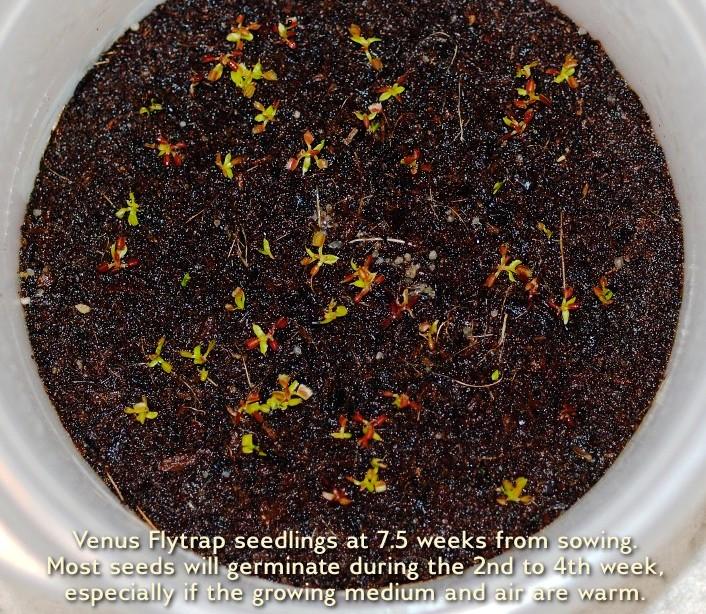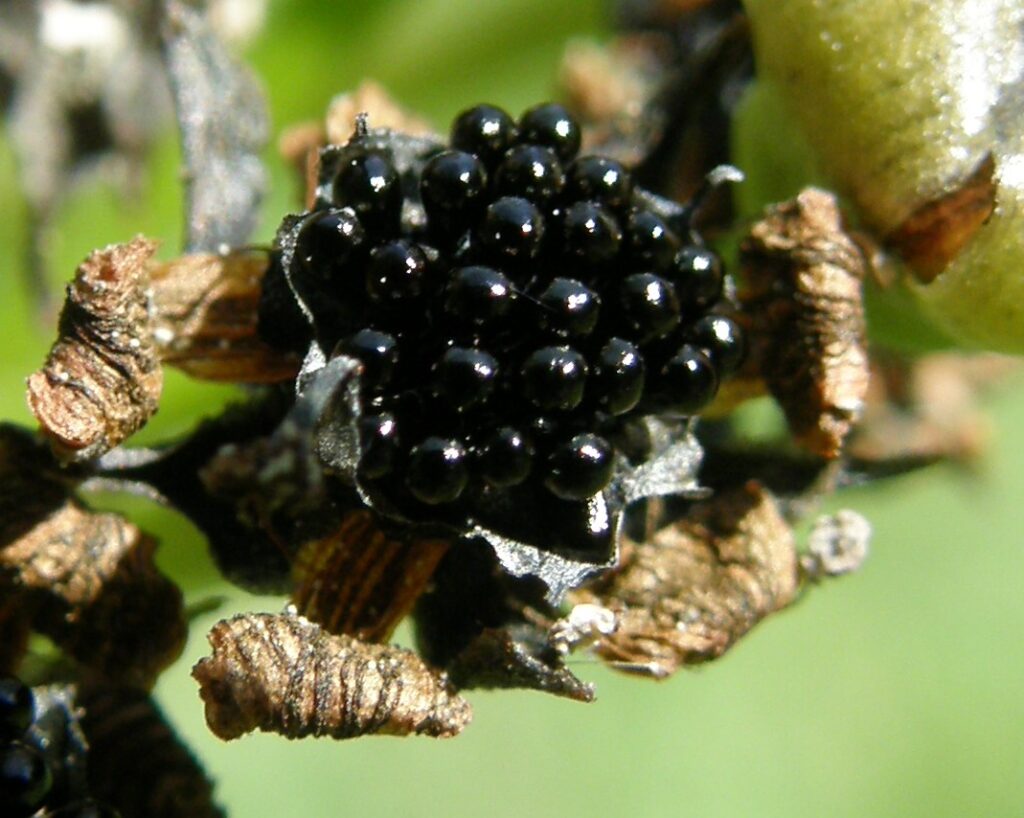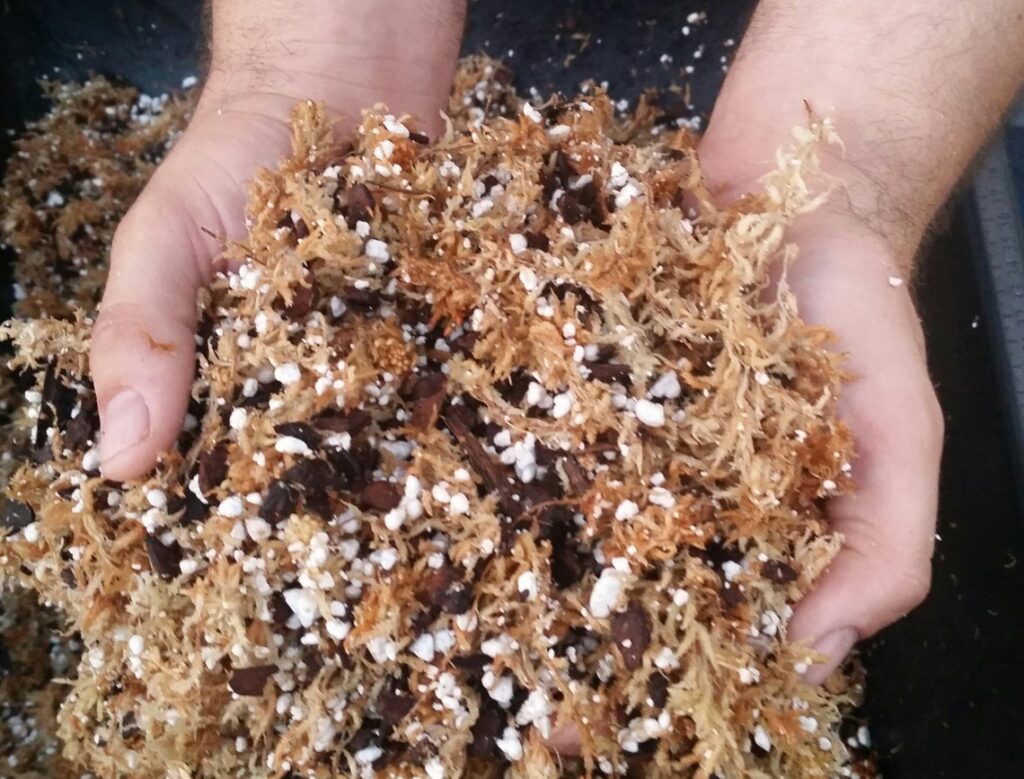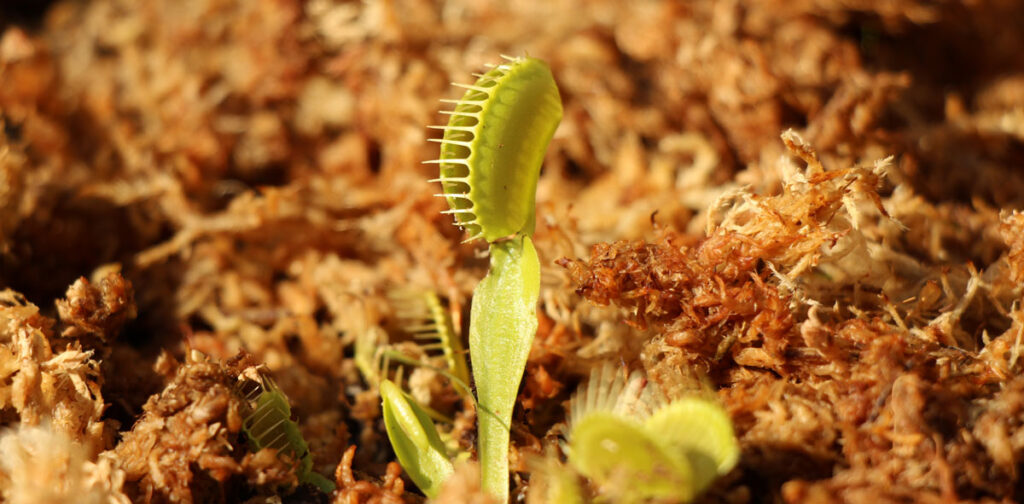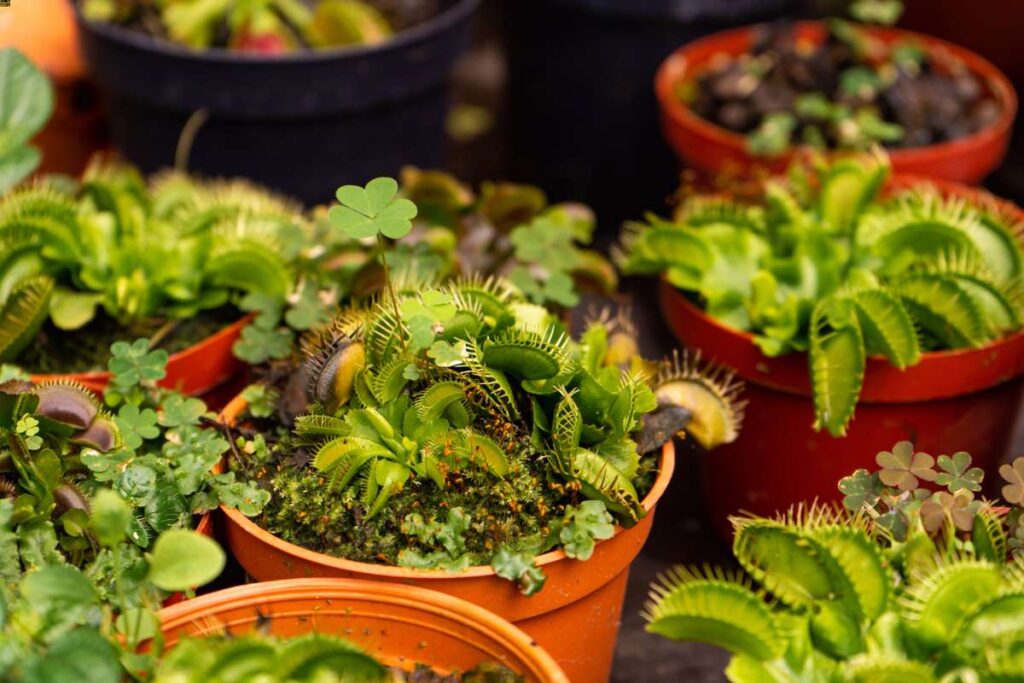How to grow venus fly trap from seeds?
It’s really simple to grow a Venus flytrap plant from seed. The seeds of the Venus flytrap, also called Dionaea muscipula, can be purchased and delivered from any location in the world. This is so because there are no laws prohibiting them in the US. In the northern hemisphere, the mature venus flytrap flowering maturity and the seed-producing season lasts from April to June.
Growing container a Venus flytrap from seed is a rewarding experience, regardless of whether you are an experienced gardener or a green-thumb newbie. Venus flytraps can be multiplied indoors in three different ways: by leaf-cutting, division, and seedling growth.
The satisfaction of possessing a flourishing Venus fly trap that you grew from seed is unmatched, even though you have to wait for the longest for results when planting Venus flytrap seeds.
This article explains how to grow Venus flytraps from seeds, from sowing to germination to a fully grown flytrap. Let’s get going.
Unique plants include venus flytraps. They can eat bugs because they are venus fly traps. They also have distinct growth stages. I will go into greater detail about the growth phases and life cycle of the Venus flytrap in this essay.
Venus flytraps can be multiplied indoors in three different ways: by leaf-cutting, division, and seedling growth. The satisfaction of possessing a flourishing Venus flytrap that you grew from seed is unmatched, despite the fact that you have to wait for the longest for results when planting Venus flytrap seeds.
The exotic grown venus flytraps require precision from their gardener. A Venus flytrap can, however, be grown by anyone with the right equipment and knowledge.
This article explains how to grow Venus flytraps from seeds, from sowing to germination to a fully grown flytrap. Let’s get going.
A Venus flytrap goes through the following growth stages:
- Germination period of seeds
- Dormancy
- Seed propagation – for flowers and blooms
- Vegetative reproduction – Growing season
- Leaf pullings, a synthetic reproduction method for adult plants
How long does it take a Venus flytrap seed to sprout?
Venus flytraps don’t require seed stratification to grow, unlike pitcher plants and many other carnivorous plants. All you need to start a Venus flytrap seed is the right soil and the right moment.
The germination of a Venus flytrap seed can take anywhere from one to five weeks. Depending on how warm an environment your Venus fly trap is in, this will change.
Why Plant Seeds?
Venus flytraps are very rewarding to grow from seed. You can enjoy the satisfaction of knowing that all of your hard work and dedication paid off when your Venus flytrap reached adulthood. Additionally, since seeds are reasonably priced, anyone can learn how to grow a Venus flytrap.
Growing a Venus Fly trap From Seed: The Process
Are you prepared to start growing season a Venus flytrap from a seed? Here is all the information you need to know about how to plant seeds for the Venus flytrap.
1. Purchasing seeds for the Venus flytrap
Getting your seeds is the first step in our how-to-grow a Venus flytrap guide. Where do you find Venus flytrap seeds since they aren’t usually just sitting around in packets at your neighborhood nursery?Venus flytrap seeds can be purchased or obtained by taking cuttings from an existing plant.
Online Venus Flytrap Seed Purchase
It’s best to order Venus flytrap seeds online from a reputable carnivorous plant grower despite the fact that many websites claim to sell them.
Taking the Seeds Out of the Pods
You can collect the seeds from the Venus fly trap plant if you already have one in your home. You’ll need to pollinate the Venus flytrap as well, which is outside the range and purview of this article. This is next-level gardening.
If your Venus flytrap has been successfully pollinated, tiny jet-black flowerheads will appear and swell with tiny seeds bursting out of the pods. You can remove the flower heads, leaving only the seed pods that developed on the flytrap’s tip.
The Venus flytrap produces tiny, dark-colored most seeds. Simply join your thumb and index finger, and draw outward from the pod’s base to its tip, to take them out.
Be careful not to rip the pod off the flowerhead when doing this. The seeds of the Venus flytrap will be freed from their pods by using a thumb and index finger motion.
2. Select the Proper Soil for Venus Flytraps
It’s time to begin planting your seeds now that you have your supply. The potting mix you use for adult Venus flytraps should be used for the young ones as well.
The ideal soil for a Venus flytrap is one that is devoid of nutrients (more on that in a moment) and has a high air-to-water ratio.
You can use peat or sphagnum moss (recommend peat moss mixed) , or you can use soil made specifically for venus flytraps produce called carnivorous plant soil. While some gardeners swear by a 1:1 sphagnum moss and silica sand, many gardeners find success with pure sphagnum. In any case, it’s crucial that you avoid using ordinary soil.
Finally, avoid adding any supplements, such as fertilizer. Your seeds of the Venus flytrap will be destroyed by the excess nitrogen in fertilizer before they even have a chance to live.
3. Get the Soil Ready for carnivorous plants
I’m going to assume you’re using sphagnum moss, but these directions also work with peat moss and soil for the most famous carnivorous plant.
Prepare two 5-inch-deep shallow containers that are filled with moss. The bottom of these small containers ought to have a drain hole. Place them both in a big, water-resistant dish.
Fill the sphagnum moss containers (Tupperware type container) with rainwater or spray distilled water until they resemble a swamp. Use bottled water instead of tap water because it contains nutrients and minerals that will kill Venus flytraps.
Scattered them onto your trays while holding all of your seeds in your hand.
Why are there two trays used? Mold and fungus can grow in any environment where we sprout from seeds, though it’s less likely to do so than, say, with cacti. You increase your chance of having a failed crop if you put all your eggs in one basket or all your seeds in one container.
4. Germinate Your Seeds in an Environment with High Humidity
Other seedlings dislike humidity, but Venus fly traps adore it. After planting the seeds, place the containers in a sizable resealable bag and seal them. The bag aids in the germination of the seedlings by serving as a sort of greenhouse.
5. Take Care of Your Seedling Venus Flytrap
Congratulations when you start to notice Venus flytrap seedlings emerging from the ground! The challenging part is over! Now let’s open the bag so the Venus flytraps can get some air as they develop.
Avoid placing the seedlings in a cold environment and try to get some sunlight on them. However, avoid placing the seedlings in an area that is too hot because too much exposure to the sun can cause the seeds to boil and perish. Place them in a well-lit space away from a lot of direct heat. A moist wooden toothpick is the best medium for transplanting the new plant in poke holes.
6. Plant new Venus flytraps.
A Venus flytrap has a very straightforward root system, so repotting is not too difficult. Turn down the container cover and remove the soil when it’s time to repot. As much soil as you can from the root system be removed, being gentle so as not to damage the newly emerging root system.
After that, moisten your chosen potting soil and place it inside the container you’ve chosen. When the pot is about three-quarters full, place your new Venus flytrap inside and hold it there until it is fully submerged. Fill in the soil with the other hand.
Make sure the Venus flytrap is not buried too deeply. Because it might rot if you bury it too deeply, the crown should be visible. Repot the flytrap and give it a thorough watering.
Put your Venus flytrap in a special container rather than any old planter. Make sure to display your venus flytrap seedling in a cool planter because it will be a great conversation starter!
Learn what to feed your Venus flytrap once it has reached the appropriate size to supplement the nutrients it receives from sunlight.
7. Continue expanding your flytrap
If you have ever raised a Venus flytrap from seed, you are familiar with the joys and challenges of being a plant parent. You shouldn’t have many issues taking care of a Venus flytrap indoors if you followed the instructions in this article.
Every one to two years, you should repot your adult venus flytraps. The best method for growing a Venus flytrap indoors is this the peat moss must remain fresh to continue holding onto water for your plant.
Germinate Venus Flytraps Seeds
When the flowers of venus flytraps are pollinated, seeds are produced. A Venus flytrap produces tiny, shiny, and dark seeds. Additionally, there is no need to stratify their seeds.
Try to germinate Venus flytrap seeds as soon after harvest as possible when growing them from seed. The likelihood of producing seedlings decreases noticeably as seeds age.
Follow these steps to get Venus flytrap seeds to sprout:
- Purchase a pot with drainage openings.
- Use reverse osmosis water, rainwater, or distilled water (not tap water) to moisten the soil of adult plant. Read this article to learn where to make or buy carnivorous plant soil if you’re unfamiliar with it. Never use regular potting soil because it can cause Venus flytraps to die. Additionally, be sure to only use the sources of pure water mentioned above.
- Put the moist soil for carnivorous mature plants in the pot. Ensure that the media is evenly moist.
- Don’t bury the seeds; instead, sow them in the ground. On top of the ground, scatter them.
- Put the pot inside a clear Ziploc bag and zip it up.
After that, give them suitable attention to help them germinate:
- Give the seeds more than six hours a day of direct sunlight.
- Never let the soil dry out; keep it moist at all times.
- To raise the humidity levels, think about seeds moist.
The germination of Venus flytrap seeds can take up to five weeks.
This article: How to grow Venus Flytrap and Other Carnivores can help you learn how to care for Venus fly trap seeds once they start growing.
FAQ
Should I do stratification?
No, not for Venus Flytrap seed. For several weeks or months, trap seeds are kept cold and damp during the stratification process. For plants that bloom in the fall, this process can simulate a winter for the seeds, which are then used to germinate the following spring. However, venus flytrap flower in the spring rather than the fall, and their seeds do not require stratification.
Instead, during the summer, Venus Flytrap seeds germinate within days (typically 13–25 days), with the rate and speed of germination increasing with warm temperatures. As a result, Venus Flytrap seeds shouldn’t be stratified. However, if they aren’t sown right away, they can be stored in a cool refrigerator to keep them fresh longer and increase germination when sown later.
How do I store seeds?
Overage seeds can be refrigerated in a small clear plastic bag for later germination. To prevent the seeds from drying out, squeeze the extra air out of the plastic bag. Preventing them from trying to germinate early by keeping them cold and keeping them fresh, and preventing them from drying out too much to keep them fresh longer and maintain a higher germination rate. If you’re collecting your own seeds, dry them out in an open container for a couple of days before storing them in the fridge to prevent mold growth (freshly harvested seeds are moister).
How can I produce my own seeds and pollinate them?
We never advise letting the flower stalk grow on your Venus flytrap plant unless you intend to collect seed because it will drain a lot of energy and the plant won’t do well that year. In the Northern Hemisphere, the flower stalk will typically grow and bloom any time between February and May if you choose to let it. Only one to one and a half days after the flower opens are flowers susceptible to pollen. Fresh pollen from a younger flower, preferably one that has just opened, should be used to pollinate flowers that are open to being pollinated.


